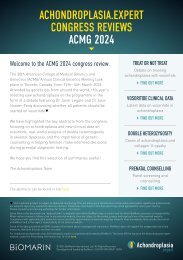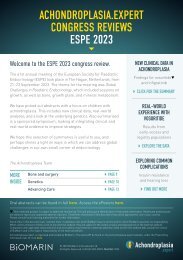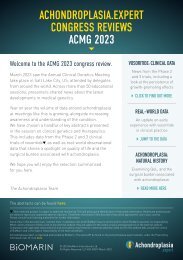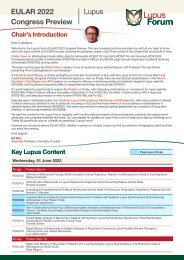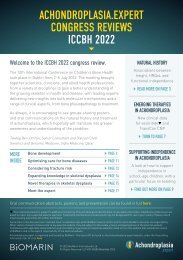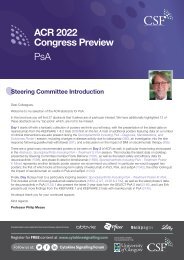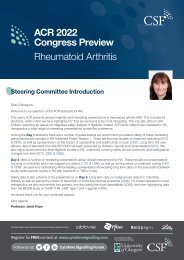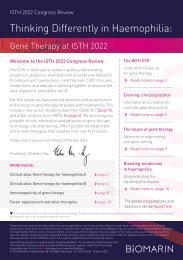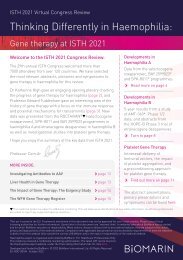ESPE 22 Congress Review
The 60th annual meeting of the European Society for Paediatric Endocrinology took place 15–17 September in Rome, Italy. Over 3,000 delegates attended for a huge programme on diseases of childhood, including dedicated sessions on bone, growth, and mineral metabolism.
The 60th annual meeting of the European Society for Paediatric Endocrinology took place 15–17 September in Rome, Italy. Over 3,000 delegates attended for a huge programme on diseases of childhood, including dedicated sessions on bone, growth, and mineral metabolism.
You also want an ePaper? Increase the reach of your titles
YUMPU automatically turns print PDFs into web optimized ePapers that Google loves.
ACHONDROPLASIA.EXPERT<br />
CONGRESS REVIEWS<br />
<strong>ESPE</strong> 20<strong>22</strong><br />
Welcome to the <strong>ESPE</strong> 20<strong>22</strong> congress review.<br />
The 60th annual meeting of the European Society for Paediatric<br />
Endocrinology took place 15–17 September in Rome, Italy.<br />
Over 3,000 delegates attended for a huge programme on<br />
diseases of childhood, including dedicated sessions on bone,<br />
growth, and mineral metabolism.<br />
We have chosen a selection of abstracts with a focus on<br />
achondroplasia and a few other topics of interest in the wider field<br />
of skeletal dysplasia. These include new analyses of appropriate<br />
patient-reported outcomes to use in children with achondroplasia,<br />
and examination of differences in everyday management.<br />
Also summarised is a sponsored symposium giving more detail<br />
on some of the early-use, real-world cohorts of patients receiving<br />
vosoritide in routine practice across Europe.<br />
We hope you will enjoy the selection of presentations summarised<br />
for you here.<br />
The Achondroplasia Team<br />
MORE<br />
INSIDE<br />
Complications and natural history PAGE 4<br />
Gene sequencing PAGE 7<br />
REAL-WORLD DATA<br />
FOR VOSORITIDE<br />
Early results in children<br />
with achondroplasia<br />
CLICK TO FIND OUT MORE<br />
THE PATIENT<br />
PERSPECTIVE<br />
Identifying diseasespecific<br />
PROs<br />
JUMP TO THE DATA<br />
EVOLVING<br />
MANAGEMENT<br />
Treatment in the age<br />
of precision therapies<br />
GET THE SUMMARY HERE<br />
Oral abstracts can be found in full here. Access the iposters here.<br />
This medicinal product is subject to additional monitoring. This will allow quick identification of new safety information. Healthcare professionals<br />
are asked to report any suspected adverse reactions. Treatments mentioned in this document may not be approved for use in your country.<br />
Please consult local licensing authorities for further information.<br />
Some links in this document are “external links” to websites over which BioMarin has no control and for which BioMarin assumes no responsibility.<br />
When visitors choose to follow a link to any external website, they are subject to the cookie, privacy and legal policies of the external website.<br />
Compliance with applicable data protection and accessibility requirements of external websites linked to from this website falls outside the control<br />
of BioMarin and is the explicit responsibility of the external website.<br />
Achondroplasia.expert is organised and funded by BioMarin. The latest API be found on the Achondroplasia.expert website, under the Prescribing<br />
Information tab. Or click here.<br />
© 20<strong>22</strong> BioMarin International Ltd.<br />
All Rights Reserved. EU-VOX-00686 October 20<strong>22</strong><br />
1
Achondroplasia.expert <strong>Congress</strong> <strong>Review</strong>s: <strong>ESPE</strong> 20<strong>22</strong><br />
VOSORITIDE: REAL-WORLD DATA<br />
Vosoritide, an analogue of C-type natriuretic peptide, has been developed<br />
for the treatment of short stature in children with achondroplasia, and was<br />
approved by the EMA in August 2021.<br />
PATIENT-REPORTED OUTCOMES<br />
Individuals with achondroplasia experience medical, emotional, and functional<br />
detriments during their lifetime. However, there are currently no validated<br />
achondroplasia-specific patient- or clinician-reported outcome measures.<br />
Palm et al. presented epidemiological<br />
data characterising the current practice<br />
of multidisciplinary treatment in Portugal,<br />
Austria, and Germany. Routine medical<br />
history and clinical data were obtained from<br />
575 children with achondroplasia under the<br />
age of 17. Since October 2021, vosoritide had<br />
been started in 164 children (29%). Of these,<br />
the majority (49%) are 2–6 years of age.<br />
Across the whole achondroplasia group,<br />
19% had received cranial decompression<br />
surgery and 8% had undergone limb<br />
lengthening. To facilitate further data<br />
collection, an achondroplasia-specific list<br />
of items has been inserted in CrescNet – a<br />
web-based registry. The group will continue<br />
to collect prospective data for longitudinal<br />
evaluation of safety and treatment responses.<br />
[P1-<strong>22</strong>3]<br />
Real-world experience with vosoritide was<br />
also shared in a poster from Cormier-Daire<br />
et al. Vosoritide was made available in<br />
France in June 2021 via an early access<br />
programme. Prioritisation of the oldest<br />
children with achondroplasia was proposed,<br />
with enrolment focusing on those aged<br />
5 years and older with open epiphyses. After<br />
treatment initiation and parent education,<br />
follow-up includes visits at Months 1, 3,<br />
and 6, and at 6-monthly intervals thereafter.<br />
Data are systematically collected to evaluate<br />
treatment compliance, AEs, and growth. To<br />
date, data are available for 29 patients from<br />
6 centres across France. At baseline, 52% were<br />
female with a mean age of 9 years. The mean<br />
height was 106.9 cm, with height z-scores<br />
ranging between –3.9 and –7.7 in males and<br />
–3.4 and –6.0 in females. The duration of<br />
treatment ranged from just under 1 month<br />
to approximately 11 months, over which<br />
time 7 patients missed a total of 13 doses,<br />
but no patients discontinued treatment.<br />
In total, there were 17 AEs reported among<br />
9 patients; the majority were mild and<br />
included injection-site reactions and vomiting,<br />
with injection-site papules being the most<br />
common (6 events). There were no serious<br />
AEs related to vosoritide, and no AEs led to<br />
permanent treatment discontinuation (please<br />
see table on page 9). The authors concluded<br />
that the overall safety profile of vosoritide over<br />
almost 12 months in a real-world setting was<br />
consistent with that observed in clinical trials.<br />
Ongoing monitoring and data collection from<br />
this early access programme will be useful to<br />
establish the ongoing real-world safety and<br />
effectiveness of vosoritide. [P1-508]<br />
In a session on growth and syndromes,<br />
Mathias et al. shared results of a detailed<br />
review of generic PRO and CRO measures,<br />
work which was undertaken in order to<br />
select relevant tools for further evaluation<br />
in a qualitative study. Based on the available<br />
literature, five PROs and one CRO were<br />
selected for further analysis, looking at how<br />
well the concepts map to common symptoms<br />
such as pain, ear infections, and low stamina<br />
or tiring easily. The measures were also<br />
examined for their ability to capture important<br />
impacts of achondroplasia, such as difficulty<br />
reaching objects and toileting. Of the six<br />
tools analysed, the QoLISSY, PedsQL, Pain-<br />
NRS, and WeeFIM were identified for further<br />
evaluation in a qualitative study of children with<br />
achondroplasia and their parents. [P1-118]<br />
Results from the group’s qualitative analysis<br />
were also shared at the meeting in a second<br />
poster. This research and mapping exercise<br />
combined concept elicitation and cognitive<br />
debriefing interviews in 26 participants<br />
via an online system that allowed screen<br />
sharing. Data from the interviews were used<br />
to map important concepts to the QoLISSY,<br />
PedsQL, Pain-NRS, and WeeFIM measures.<br />
The findings showed that pain was the most<br />
common symptom for both children and their<br />
parents (88%/83%), followed by feeling hot<br />
or sweaty (88%/78%). Overall, 50% of both<br />
children and parents reported difficulties<br />
with concentrating and remembering.<br />
Other common complications included sleep<br />
apnoea (13%/50%), speech issues (63%/50%),<br />
ear infections (50%/78%), and balance<br />
problems (75%/56%). The most common<br />
impacts were difficulty reaching objects<br />
(88%/78%), toileting (25%/63%) and bathing<br />
(38%/56%). Mapping confirmed that the<br />
QoLISSY, PedsQL, Pain-NRS, and WeeFIM<br />
tools cover the most important concepts.<br />
WeeFIM – the only CRO examined – contains<br />
important concepts not included in the three<br />
PROs such as difficulty bathing, dressing, and<br />
toileting. All participants said that PedsQL<br />
and QoLISSY were easy to complete, and<br />
over 90% thought that the items were relevant.<br />
Although the PedsQL was considered by<br />
67% of respondents to be easier to understand,<br />
61% said the content of the QoLISSY was<br />
more relevant. Most participants (79%)<br />
recommended inclusion of both measures.<br />
Pain-NRS was considered clear (88%),<br />
relevant (88%), and easy to complete (81%).<br />
The authors conclude that this comprehensive<br />
assessment provides important information<br />
on achondroplasia-related medical challenges<br />
and impacts from the perspective of both<br />
the child and the parent. Results suggest<br />
the PedsQL, QoLISSY, and Pain-NRS – in<br />
conjunction with the clinician-administered<br />
WeeFIM – map well to important concepts<br />
identified during interviews, and all measures<br />
were clear, relevant and content valid<br />
to children and parents of children with<br />
achondroplasia. [P1-327]<br />
2 3
Achondroplasia.expert <strong>Congress</strong> <strong>Review</strong>s: <strong>ESPE</strong> 20<strong>22</strong><br />
COMPLICATIONS & NATURAL HISTORY<br />
Achondroplasia is associated with a variety of complications across the lifespan.<br />
Understanding these is important to provide holistic care and management.<br />
Despite a European consensus on principles<br />
for the management of achondroplasia<br />
providing a basis for optimal care, differences<br />
in clinical approach still exist – not only<br />
between countries, but also within local<br />
and regional contexts. As for other rare<br />
diseases, data and literature supporting best<br />
management practices in achondroplasia are<br />
often limited, specifically at the single country<br />
level. Antoniazzi et al. structured two onlinesurveys<br />
for 493 clinicians and 42 parents/<br />
caregivers of patients with achondroplasia.<br />
Overall, 39% of parents/caregivers reported<br />
the greatest impact of achondroplasiarelated<br />
complications was during the ages<br />
of 2–5 years. The routine care provided to<br />
subjects with significant complications<br />
was performed by the reference centre in<br />
two-thirds of cases, with others receiving<br />
routine care by a specialist near their place of<br />
residence. The frequency of reference centre<br />
visits differed by patient age, and around<br />
40% of subjects were required to travel a<br />
considerable distance (over 200 km) to access<br />
routine care, which may represent a barrier to<br />
adequate management. The results revealed<br />
agreement between the two groups on the<br />
need for improvement in a number of areas,<br />
such as reinforcing psychological support,<br />
more structured multidisciplinary teams, and<br />
for better follow-up and transition to adult<br />
care. Clinicians also highlighted the need for<br />
more active involvement of territorial services<br />
throughout the patient journey, while patients<br />
recognised issues in terms of access to care.<br />
The project provides important insight into the<br />
real-world management of achondroplasia in<br />
Italy for the first time, and has the potential to<br />
help improve patient management and patient<br />
outcomes in this condition. [P1-330]<br />
Cebeci et al. presented a case report on<br />
SIADH as a presenting feature of foramen<br />
magnum stenosis – a severe complication<br />
in infancy that can be associated with<br />
cervicomedullary compression and sudden<br />
death. A 2-month-old boy with prenatally<br />
diagnosed achondroplasia was referred<br />
due to disordered breathing and altered<br />
consciousness. On physical examination,<br />
the patient was apathic, pale, hypotonic,<br />
and hypothermic, with typical features of<br />
achondroplasia. Shallow breathing with<br />
nasal flaring and suprasternal retractions<br />
and deep sighing was compatible with<br />
central apnoea, and blood gas analysis<br />
revealed respiratory acidosis. The patient<br />
was intubated, and laboratory investigations<br />
revealed severe hyponatremia and<br />
hypochloridaemia with normal glucose and<br />
urea levels, but high urinary sodium-output.<br />
The diagnosis of SIADH was made based<br />
on low serum osmolality in the presence<br />
of high urine osmolality and treatment<br />
was started. An emergency CT showed a<br />
high-grade stenosis at the cranio-cervical<br />
junction, and subsequent MRI demonstrated<br />
myelocompression (AFMS 4b). The patient<br />
underwent decompression surgery the next<br />
day. Prompt improvement of laboratory<br />
Distribution of signs and symptoms by age group<br />
Patients<br />
100%<br />
90%<br />
80%<br />
70%<br />
60%<br />
50%<br />
40%<br />
30%<br />
20%<br />
10%<br />
0%<br />
Otitis<br />
Sleep apnoea and<br />
breathing disorders<br />
Specialists consulted in the previous 2 years, by patient age group<br />
Patients<br />
100%<br />
90%<br />
80%<br />
70%<br />
60%<br />
50%<br />
40%<br />
30%<br />
20%<br />
10%<br />
9%<br />
43%<br />
40% 40%<br />
67%<br />
27% 29% 33% 60%<br />
0% 0% 0% 0% 0% 0%<br />
36%<br />
57%<br />
67%<br />
100%<br />
100%<br />
45%<br />
71% 60%80% 67%<br />
parameters was observed after operation.<br />
Spontaneous breathing after extubation<br />
was sufficient; however, only reduced<br />
spontaneous motor activity of the extremities<br />
was observed in the course, assumed due to<br />
a high-level spinal injury. This case highlights<br />
33%<br />
Signs of foramen magnum<br />
stenosis and cervicomedullary<br />
compression<br />
Complications<br />
45%<br />
57%<br />
13%<br />
71%<br />
71%<br />
40%<br />
60%<br />
55%<br />
45% 40%<br />
40%<br />
33%<br />
33%<br />
47%<br />
14%<br />
36%<br />
0–1 years<br />
2–5 years<br />
6–8 years<br />
9–12 years<br />
13–16 years<br />
>16 years<br />
43% 40%<br />
20%<br />
Hearing difficulties<br />
or hearing loss<br />
33%<br />
Antoniazzi et al. [P1-330]<br />
0–1 years<br />
2–5 years<br />
6–8 years<br />
9–12 years<br />
13–16 years<br />
>16 years<br />
0% 0% 0% 0% 0% 0% 0% 0%<br />
Orthopaedic Physiotherapist ENT specialist Neurosurgeon Clinical<br />
Paediatric<br />
surgeon<br />
geneticist endocrinologist<br />
or endocrinologist<br />
Clinician Specialty<br />
Antoniazzi et al. [P1-330]<br />
60%<br />
33%<br />
the need for clinicians to be aware of SIADH<br />
as a presenting sign of foramen magnum<br />
stenosis in children with achondroplasia.<br />
Other symptoms include feeding difficulties,<br />
respiratory distress, seizures, apnoea, and<br />
movement asymmetry. Further discussion is<br />
9%<br />
29% 33% 20%<br />
33%<br />
4 5
Achondroplasia.expert <strong>Congress</strong> <strong>Review</strong>s: <strong>ESPE</strong> 20<strong>22</strong><br />
needed regarding improved family education<br />
and timing of screening and neuroimaging<br />
recommendations, especially in children who<br />
did not receive polysomnography. [P1-24]<br />
Bone age is commonly used in paediatrics<br />
to define skeletal maturity for medical and<br />
non-medical purposes. Normal range is<br />
represented by 2 SDs above and below the<br />
mean. However, bone age in achondroplasia<br />
has not been fully characterised, and<br />
calculation is challenging. Previous<br />
publications have described delays in bone<br />
age in children with achondroplasia; one<br />
study showed a delay of 1.4 years for males<br />
and 1.2 years for females. In this poster,<br />
Savarirayan et al. described bone age at<br />
baseline in a group of children participating<br />
in PROPEL2 – a Phase 2 dose-finding study<br />
evaluating the preliminary safety and efficacy<br />
of infigratinib in achondroplasia. Left-hand<br />
radiographs from 37 children were evaluated<br />
for bone age by a single reader. Bone age in<br />
BA/CA in participants<br />
2.0<br />
relation to chronological age was expressed<br />
as BA/CA, BA-CA overall, and by sex. Results<br />
showed mean bone age was 8.2 (P=0.1 versus<br />
chronological age). BA/CA was 1.06, and<br />
BA-CA was 0.37 years. Mean BA/CA was<br />
1.12 in females and 0.93 in males, a<br />
statistically significant difference (P=0.026).<br />
Overall, 6 children (16.2%; 5 female,<br />
1 male) had bone age greater than +2 SDs<br />
for age and sex, indicating an advanced<br />
bone age compared with chronological age.<br />
In contrast, 4 children (10.8%; 1 female,<br />
3 male) had delayed bone age compared<br />
with chronological age. The group concluded<br />
that this analysis did not confirm any delay<br />
in bone age in pre-pubertal children with<br />
achondroplasia. Bone age in females was<br />
more advanced than in males, but within the<br />
expected variability for the age group. This<br />
work suggests that bone age estimation in<br />
children with achondroplasia can be employed<br />
for the same purposes as in children without<br />
skeletal dysplasia. [P1-306]<br />
*<br />
*p=0.026<br />
GENE SEQUENCING<br />
Most children with short stature remain without an etiologic diagnosis<br />
after extensive clinical and laboratory evaluation and are classified as<br />
idiopathic short stature.<br />
Andrade et al. set out to determine the<br />
diagnostic yield of a multigene gene<br />
analysis in 102 children classified as having<br />
idiopathic short stature. Customised<br />
target panel sequencing was developed,<br />
including all genes already implicated in<br />
isolated short stature phenotypes. Rare and<br />
deleterious single nucleotide or copy number<br />
variants were assessed by bioinformatic<br />
tools. Findings identified 20 heterozygous<br />
pathogenic (P) or likely pathogenic (LP)<br />
genetic variants in 17 patients (diagnostic<br />
yield: 16.7%). Three patients had more than<br />
one P/LP genetic alteration. Most of the<br />
findings were in genes associated with the<br />
growth plate development such as IHH,<br />
SHOX, FGFR3, NPR2, ACAN, and COL2A1 –<br />
or those involved in the RAS/MAPK pathway.<br />
The diagnostic yield was higher among<br />
children with severe short stature (P=0.034),<br />
but there was no significant difference in the<br />
rate of positive genetic diagnosis observed<br />
regarding familial short stature (P=0.129),<br />
or presence of mild body disproportion<br />
(P=0.116). No patient had clinical findings<br />
to guide a candidate gene approach.<br />
The authors conclude that a multigene<br />
sequencing approach is able to determine a<br />
genetic aetiology of short stature in up to one<br />
in six children, therefore removing the term<br />
idiopathic from their clinical classification.<br />
These findings are important, since knowing<br />
the genetic basis of short stature can<br />
allow precise genetic counselling. This is<br />
particularly relevant for children harbouring<br />
variants in the RAS-MAPK pathway, and<br />
with the potential to trigger development<br />
of specific treatment protocols. [P1-111]<br />
BA/CA<br />
1.8<br />
1.6<br />
1.4<br />
1.2<br />
1.0<br />
0.8<br />
0.6<br />
0.4<br />
EVOLVING MANAGEMENT<br />
This BioMarin-sponsored symposium looked at the management of<br />
achondroplasia in the age of precision therapies. The session was chaired<br />
by Professor Mohamad Maghnie.<br />
0.2<br />
0<br />
Overall Males Females<br />
The lower and upper bounds of the rectangles represent the first and third quartiles, the horizontal line represents the median,<br />
the whiskers extend to the highest and lowest values within 1.5-times the interquartile range, and data<br />
beyond the end of the whiskers are outliers and are plotted as points. The X represents the mean.<br />
Savarirayan et al. [P1-306]<br />
Dr Melita Irving opened the session<br />
with updates from the vosoritide clinical<br />
programme. Vosoritide is a targeted<br />
therapy for achondroplasia, which works<br />
to counteract the effects of constitutively<br />
active FGFR3, enhancing endochondral<br />
bone growth. 1 It was approved in Europe in<br />
August 2021 for patients at least 2 years of<br />
age whose epiphyses are not closed. 2<br />
6 7
Achondroplasia.expert <strong>Congress</strong> <strong>Review</strong>s: <strong>ESPE</strong> 20<strong>22</strong><br />
There was a significant cumulative height gain<br />
versus natural history controls over 5 years<br />
The vosoritide clinical trials (111-<br />
in the Phase 2 study, with a cumulative<br />
202/205, 111-301/302, and 111-206)<br />
additional height gain over untreated patients<br />
have shown a consistent safety profile,<br />
of +9.08 cm. 2 Significant cumulative height<br />
with comparable incidence of side effects<br />
gain was also seen in Phase 3, with +3.34 gain<br />
versus placebo across ages in patients<br />
over 2 years, alongside significantly increased<br />
with achondroplasia aged ≥2 years<br />
AGV and improvements in height Z-scores.<br />
whose epiphyses are not closed. 2–4<br />
3–6<br />
Emerging clinical trial data in younger<br />
patients show a comparable impact of Professor Valérie Cormier-Daire and<br />
vosoritide treatment on height Z-scores Professor Klaus Mohnike presented early<br />
for patients ≥2 to
Achondroplasia.expert <strong>Congress</strong> <strong>Review</strong>s: <strong>ESPE</strong> 20<strong>22</strong><br />
from clinical practice is key to establish longterm<br />
safety and effectiveness of vosoritide<br />
in the real world, and sharing these early<br />
experiences with vosoritide is essential for<br />
best practice evaluation and developing<br />
standards and guidelines for patient care.<br />
These early experiences highlight some<br />
common practices that are essential for<br />
successful therapy initiation. From a patient<br />
and family perspective, there is a need to<br />
establish readiness of treatment, and to<br />
ensure an appropriate level of caregiver<br />
information and training, with readily available<br />
support from the healthcare team. Alongside<br />
this, there is a need to ensure site preparation,<br />
with a well-connected multidisciplinary team,<br />
regular routine follow-ups, and well-planned<br />
logistics and storage arrangements for<br />
pharmacies and families.<br />
LIST OF ABBREVIATIONS<br />
AFMS – achondroplasia foramen magnum score<br />
AGV – annualised growth velocity<br />
cGMP – cyclic guanosine monophosphate<br />
CRO – clinician-reported outcome<br />
CT – computed tomography<br />
ENT – ear, nose, and throat<br />
ERK1 – extracellular signal-regulated kinase 1<br />
EMA – European Medicines Agency<br />
FGFR3 – fibroblast growth factor receptor 3<br />
MAPK – mitogen-activated protein kinase<br />
MRI – magnetic resonance imaging<br />
Pain-NRS – pain numeric rating scale<br />
PedsQL – Pediatric Quality of Life Inventory<br />
PRO – patient-reported outcome<br />
QoLISSY Brief – Quality of Life in Short Stature Youth<br />
SD – standard deviation<br />
SIADH – syndrome of inappropriate antidiuretic<br />
hormone secretion<br />
WeeFIM – Pediatric Functional Independence<br />
Measure<br />
REFERENCES<br />
1. Lorget F, et al. Am J Hum Genet 2012;<br />
91:1108–14.<br />
2. VOXZOGO ® (vosoritide) Summary of Product<br />
Characteristics.<br />
3. Savarirayan R, et al. Lancet 2020;396:684–92.<br />
4. Savarirayan R, et al. Genet Med 2021;<br />
23:2443–7.<br />
5. Savarirayan R, et al. Poster presented at<br />
ENDO 20<strong>22</strong>.<br />
6. Savarirayan R, et al. N Engl J Med 2019;<br />
381:25–35<br />
7. https://clinicaltrials.gov NCT01603095<br />
8. https://clinicaltrials.gov NCT02055157<br />
9. https://clinicaltrials.gov NCT02724<strong>22</strong>8<br />
10. https://clinicaltrials.gov NCT03197766<br />
11. https://clinicaltrials.gov NCT03424018<br />
12. https://clinicaltrials.gov NCT03583697<br />
13. https://clinicaltrials.gov NCT03989947<br />
14. https://clinicaltrials.gov NCT04554940<br />
15. https://clinicaltrials.gov NCT03872531 (LISA)<br />
16. https://clinicaltrials.gov NCT03449368 (LIAISE)<br />
10




